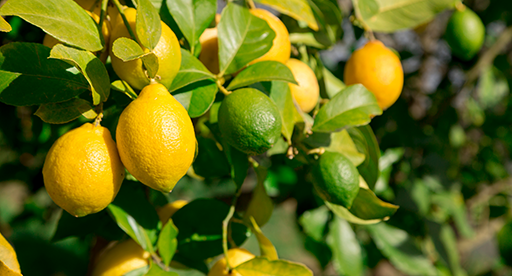
5 Steps to Lemon Success
- Pick a lemon variety based on your garden and cooking needs and choose a consistently sunny spot sheltered from cold winds.
- Prepare your soil with organic matter like compost and sheep pellets.
- Add a layer of citrus and fruit mix to plant into. In New Zealand plant lemons in spring, autumn and winter (only where frosts aren't prevalent).
- Feed your lemons in spring and summer to encourage maximum flowering and fruiting.
- Mulch and water well, particularly over the warmer months.
Follow our full guide below to a bumper crop of homegrown lemons.
Lemon trees are very prolific. Look after them and they will reward you with an abundance of sweet, tangy fruit. A lemon tree will nestle into the sunniest of spots, next to decks and verandas, or as a centrepiece in a container on a balcony. In addition to vitamin C, lemons are very high in potassium.
Prepare
Despite being available year-round, the lemon's true season is late winter through spring. Choose a variety based on your taste buds and cooking preferences. Popular varieties include Eureka, Meyer and Lemonade.
Choose a suitable spot: lemon trees are frost tender and they do best in a consistently sunny environment with adequate rainfall, in an area sheltered from cold winds.
Plant
Like building a house a good foundation is the key to success in your garden. The better the soil, the better your plants will grow. If you are starting with an existing garden bed dig in organic matter like Tui Sheep Pellets and Tui Compost to your soil. Then you can add a layer of Tui Citrus & Fruit Mix. If planting in pots and containers, fill with Tui Citrus & Fruit Mix.
The best times to plant are early in the morning or late in the day, so the plants aren’t exposed to the hot sun straight away. Always water plants well before and after planting.
Planting in the garden:
- Soak your tree in a bucket of Tui Organic Seaweed Plant Tonic before planting and allow to drain. This will help prevent transplant shock and give your lemon a healthy start.
- Add a layer of Tui Citrus & Fruit Mix to the planting area.
- Dig a hole, approximately twice the depth and width of the root ball of your plant.
- Gently take the plant from the current container, loosen the root ball and remove any loose or dead plant material and roots.
- Fill in with Tui Citrus & Fruit Mix. Press mix gently around the base of the plant.
- It is a good idea to stake when planting, as citrus don't like having their roots disturbed - this will help support the tree.
- Water your plant well and continue to water regularly.
Planting in pots and containers:
- Soak your tree in a bucket of Tui Organic Seaweed Plant Tonic before planting and allow to drain. This will help prevent transplant shock and give your lemon a healthy start.
- Half fill your container with Tui Citrus & Fruit Mix.
- Gently take the plant from the current container, loosen the root ball and remove any loose or dead plant material and roots.
- Position the plant in the centre of the new container and fill with Tui Citrus & Fruit Mix up to 3cm from the top.
- Gently firm the mix around the base of the plant. The mix should be at the same level on the plant as it was in the previous container.
- Water your plant well and continue to water regularly.
In the first year after planting your lemon tree, remove any fruit that sets. This allows the tree to establish itself and encourages better fruiting in the following seasons.
Nourish
Replenishing nutrients used by your lemon tree ensures they will grow to their full potential, producing abundant and juicy crops. Feed your lemon tree in spring and summer to encourage maximum fruiting and flowering. Citrus require higher levels of potassium and magnesium, and Tui Citrus Food is specially blended with all the nutrients needed for citrus planted in gardens. Feed lemon trees planted in containers with Tui Performance Organics Citrus & Fruit fertiliser.
Magnesium deficiencies can be common in citrus, shown by yellowing leaves. Apply Tui Epsom Salts around the drip line of the lemon tree (where the leaves extend to), to correct the deficiency.
Lemons require more watering over the summer months - and well watered, well nourished lemon tree will have a better chance of keeping insect pests and diseases at bay.
The weather, weeds, pest insects and diseases can all impact on the success of your citrus. Protect your plants from the elements with layers of mulch, to help keep their roots moist. Keep the area around your lemon tree weed free.
If your lemon leaves are curling, check out our information here >
Prune if you need to for either a desired shape, to remove any diseased stems, or to improve air circulation. Remember leaves are the life of the tree, so don’t cut unnecessarily, particularly before the tree has matured. If you are pruning avoid September/October as you run the risk of lemon tree borer laying eggs in the fresh cuts.
- Jan
- Feb
- Mar
- Apr
- May
- Jun
- Jul
- Aug
- Sep
- Oct
- Nov
- Dec
- Harvest in 2-4 years